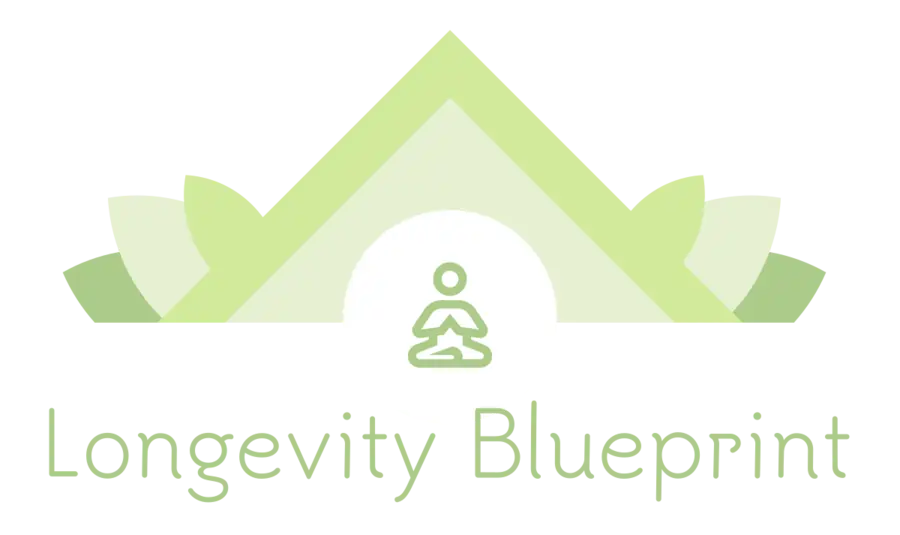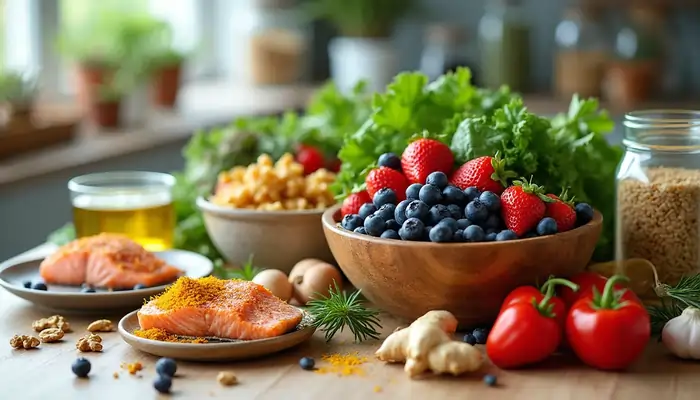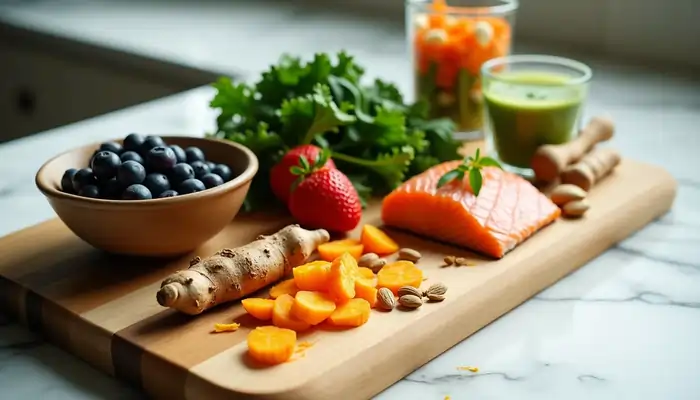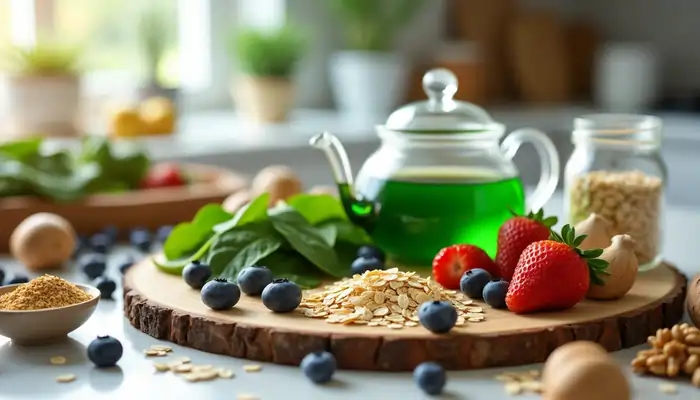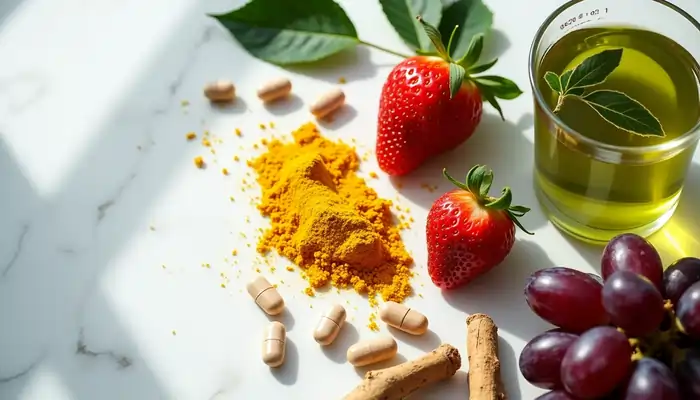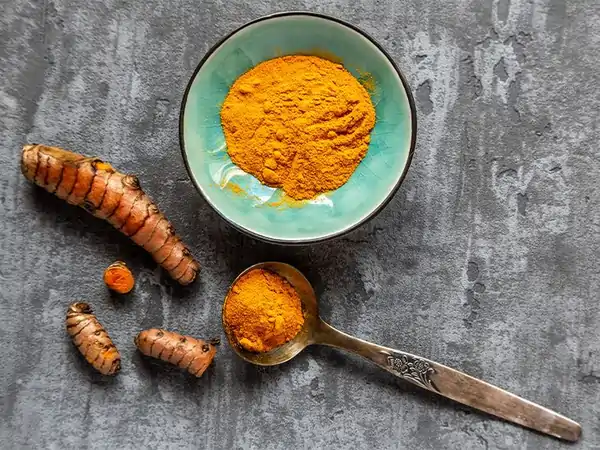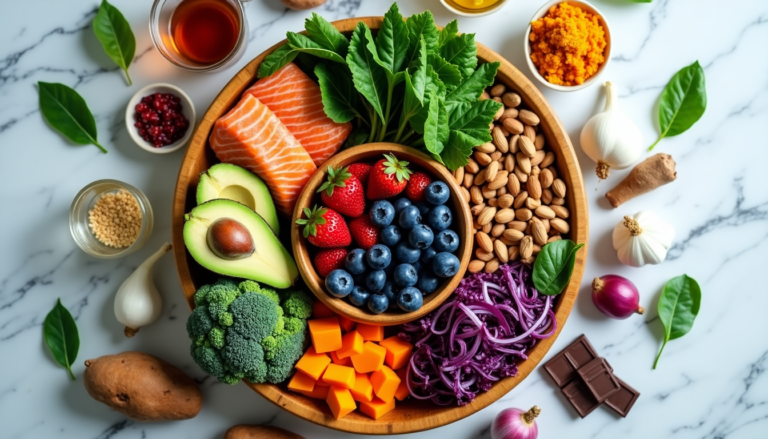The Blue Zone Diet Secret: Why These People Live Past 100 Years
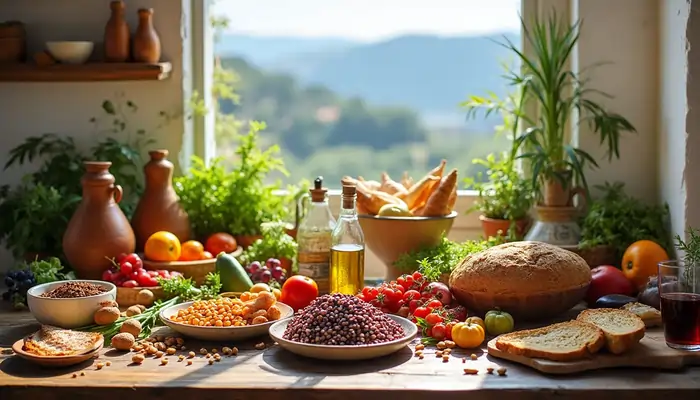
As someone who is very interested in longevity, I was always wondering what is the blue zone diet secret?! People living in blue zones teach us something unexpected about long life: genes only influence 20% of how long we might live. The Danish Twin Study shows that our lifestyle choices, especially what we eat, determine the other 80%. This explains why residents in these five unique regions keep living past 100 years with few chronic health issues.
Blue zones exist in different parts of the world – Loma Linda, California; Nicoya, Costa Rica; Ikaria, Greece; Sardinia, Italy; and Okinawa, Japan. These places share some fascinating eating patterns. The blue zone diet is simple but powerful. It relies almost entirely on plants (95-100%), focusing on vegetables, fruits, whole grains, and beans.
The sort of thing I love about this research is how vegetarian Adventists in Loma Linda tend to live eight years longer than their meat-eating neighbors. Middle-aged Ikarians who use six tablespoons of olive oil each day cut their death risk by half. These aren’t random facts – they’re useful tips we can add to our daily lives.
American eating habits tell a different story. The average American eats 22 teaspoons of added sugar daily, while blue zone residents stick to just 7. These long-lived people’s diet includes four times more beans than Americans eat – the life-blood of their remarkable longevity.
What is a Blue Zone Diet Secret?
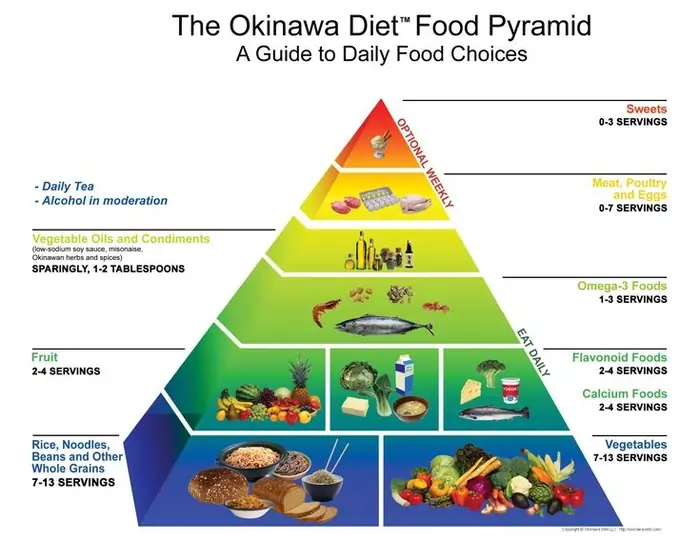
Image Source: in.pinterest.com
Picture neighborhoods where people living past 100 isn’t unusual – it’s normal. Scientists discovered “blue zones” during an eye-opening experience to understand why some people live such long, healthy lives. These unique places show us that food choices significantly impact both lifespan and “healthspan”—the time we spend in good health [1].
The origin of Blue Zones
The remarkable blue zones story started in 2004. Dan Buettner, a National Geographic Explorer and journalist, led a project to study places with exceptional longevity [1]. Scientists Gianni Pes and Michel Poulain coined the term after finding Sardinia, Italy had the highest number of male centenarians [1].
Scientists drew blue circles on maps to mark villages where people lived longer than usual. These areas became known as “blue zones” [1]. Buettner and his research team made several trips to interview hundreds of centenarians. They found five regions where people regularly live beyond 100 years with amazing health [1][1].
The five officially recognized blue zones include:
- Okinawa, Japan – Women here live longer than anywhere else in the world [2]
- Sardinia, Italy – The Ogliastra region stands out for its long-lived men [1][2]
- Nicoya Peninsula, Costa Rica – People here age more slowly biologically [2]
- Ikaria, Greece – Known as the “Island of Long Life” [2][3]
- Loma Linda, California – Seventh-day Adventists here live 10 years longer than average Americans [2]
Buettner worked with demographers, epidemiologists, and researchers to verify centenarians’ ages. They looked through birth records, marriage certificates, and other official documents [3].
Common traits of Blue Zone regions
Blue zone inhabitants share surprising food habits despite living on different continents with varied cultures. They eat mostly whole, unprocessed foods and follow plant-based diets [2][4].
Buettner’s research team analyzed 154 dietary surveys from all five blue zones. They discovered that 95 percent of centenarians ate plant-based diets with lots of beans [4]. These people aren’t strict vegetarians – they eat small amounts of meat about five times monthly [5][1].
Vegetables, fruits, whole grains, beans, and nuts make up most of their meals. Animal products account for just 5% of what they eat [1]. Sugar intake stays low at seven teaspoons daily, and processed foods rarely appear on their plates [1][5].
Blue zone eating isn’t a temporary fix – it’s a lifelong habit deeply rooted in their culture [4]. People eat their biggest meal early and have their smallest meal in late afternoon or early evening [4][5].
How diet fits into the Blue Zone lifestyle
Long life in blue zones comes from more than just food choices. It’s part of a complete lifestyle. Buettner’s team found nine lifestyle traits common to all blue zones, called the “Power 9” [1][6].
The Okinawan practice of “Hara Hachi Bu” teaches people to eat until they’re 80% full. This natural portion control helps maintain healthy weight without counting calories [2][2][2][4].
Food brings people together in blue zones. Instead of eating alone, centenarians share meals with family and friends. These social connections around food help people live longer [1][6].
Cooking becomes a mindful activity in blue zones. Sardinians spend hours making sourdough bread from scratch. Okinawans tend their gardens with care [5][4]. These activities provide natural exercise throughout the day [1].
The blue zone approach works because it combines healthy eating with overall wellness. Plant-based foods rich in antioxidants help fight chronic diseases [5]. This eating style, plus regular movement, strong friendships, and stress management, creates the perfect recipe for a longer, better life [6].
The 95% Plant-Based Rule
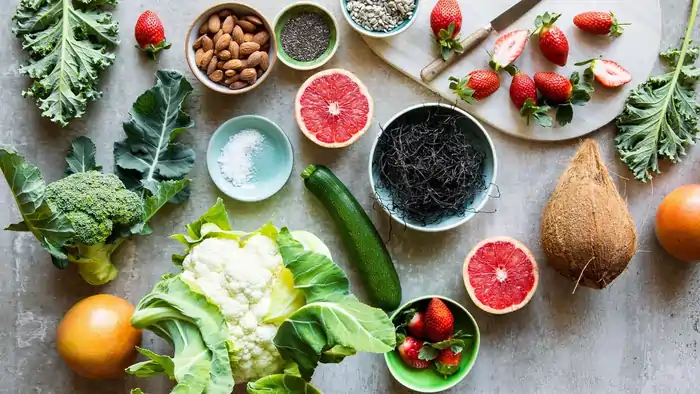
Image Source: Everyday Health
People living in all five Blue Zones share one striking eating habit that goes against typical Western diets: their food is about 95% plant-based [5]. This isn’t some new health fad. It’s a centuries-old way of eating that’s linked to their amazing long lives. Their plates tell us more than just what they like to eat – they show us powerful health lessons.
Why plants dominate the Blue Zone food pyramid
Blue Zone residents aren’t strict vegetarians, but plants are the foundations of their meals. These communities naturally evolved to eat what was available – local, seasonal produce that helps their bodies thrive [4].
Many families grow their own chemical-free vegetables, which creates a special bond with their food [4]. These people eat very few processed foods their whole lives. This lets their bodies benefit from nature’s own medicine cabinet of phytonutrients [2].
Research shows some amazing results. Middle-aged people who ate just one cup of cooked greens daily were half as likely to die in the next four years compared to those who ate none [3]. On top of that, people who ate a quarter pound of fruit daily cut their death risk by 60% during that same time [3].
Scientists found that eating even 20 grams of beans daily (less than an ounce) lowered a person’s risk of dying in any given year by about 8% [3]. So beans are the life-blood of every Blue Zone diet worldwide.
Top plant foods: greens, yams, fruits, and grains
Leafy greens shine as nutrition champions in the Blue Zone diet. Ikaria’s residents alone gather more than 75 types of wild greens that have up to ten times the polyphenols of red wine [3]. These include:
- Dark leafy greens: Spinach, kale, collards, Swiss chard, and beet tops—packed with vitamins A and C plus antioxidants [7]
- Sweet potatoes and yams: These are Okinawa’s staples, once making up over half of their daily calories [5]
- Beans and legumes: Black beans, fava beans, lentils, chickpeas—the life-blood of every Blue Zone diet [4]
- Whole grains: Sourdough bread, barley, oats, and corn—giving steady energy without blood sugar spikes [2]
- Seasonal fruits: Especially berries, which help keep brain health and blood pressure in check [7]
These foods give you fiber, complex carbs, and plant proteins without the inflammation that comes with many modern processed foods. Blue Zone communities put emphasis on whole foods—simple items that are raw, cooked, ground, or fermented [2].
How to build a plant-slant plate
You can start eating this way by filling half your plate with vegetables at lunch and dinner [1]. This simple habit naturally leaves less room for unhealthy options while giving you fiber and key nutrients.
Try making beans your main protein source. Eat at least a half cup of beans daily—black beans, lentils, or chickpeas [4]. You can easily add them to soups, salads, or main dishes.
When you want that meaty taste, try plant-based options. Jackfruit has a meat-like texture that soaks up seasonings well. Black beans work great instead of ground beef in stuffed peppers [5]. These swaps help you keep that 95% plant-based ratio while still enjoying your meals.
If protein is your concern, note that beans are about 21% protein and 77% complex carbs with very little fat [3]. Mix whole grains with beans and you’ll get complete proteins with all essential amino acids [8].
As you make these changes, focus on adding new foods rather than cutting things out. Slowly increase your plant foods and you’ll naturally eat fewer processed items without feeling restricted. The Blue Zone way of eating isn’t some quick fix – it’s a lasting lifestyle that’s helped people live longer for generations.
Meat and Fish: Rare, Not Regular
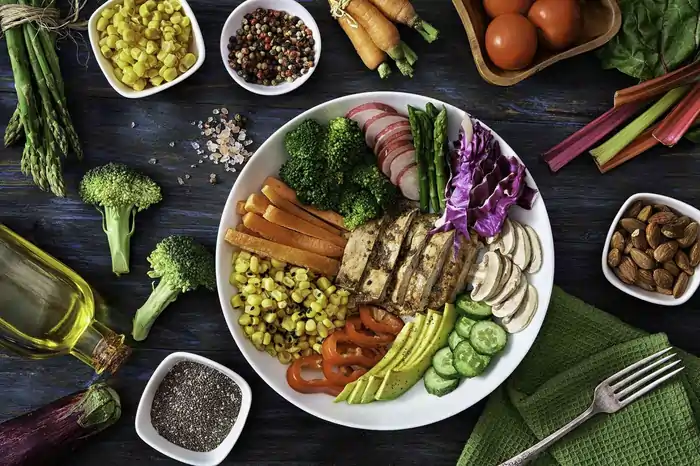
Image Source: Health
Americans think meat should be the star of every meal. Blue Zone centenarians take a radically different path. These longevity hotspots put meat on their plates just a few times each month, not daily. This challenges our modern protein obsession [6]. The contrast between their eating patterns and Western habits, where meat dominates every meal, tells an interesting story.
How often Blue Zone people eat meat
People in four of the five Blue Zones eat meat, but not much of either. They use it as celebration food, a small side dish, or to add flavor [6]. Blue Zone residents eat about two ounces or less roughly five times monthly [6]. Picture a deck of cards – that’s the size of their portion before cooking.
These families would slaughter a pig or goat only during festivals. Special occasions called for hearty meat enjoyment. They preserved the leftovers to use as a condiment or cooking fat [3]. Yes, it is quite different from European habits, where people consume about 200 grams of meat each day [3].
The blue zone diet plan puts a premium on meat quality. Animals roam freely in these regions. They eat natural diets without hormones, pesticides, or antibiotics [3]. Goats munch on grasses and herbs all day. Sardinian and Ikarian pigs search for wild acorns and roots. This likely results in meat with higher levels of healthy omega-3 fatty acids [3].
Fish as a protein source: how much is too much?
The blue zone longevity diet shows similar restraint with fish. Blue Zone inhabitants typically eat up to three small servings of fish weekly [6]. Each serving matches the size of a deck of cards before cooking [3]. Coastal areas like Ikaria and Sardinia eat more fish than others [3].
The Adventist Health Study 2 tracked 96,000 Americans since 2002. It revealed something unexpected about protein sources and longevity. The people who lived longest weren’t strict vegans or regular meat-eaters. “Pesco-vegetarians” who ate plants and small amounts of fish topped the charts [6]. This eating pattern seems to work best for a long life.
Blue zone food choices stand out because they prefer specific fish types:
- Small, inexpensive varieties like sardines and anchovies
- Middle-of-the-food-chain species like cod
- Fresh, locally caught options low in mercury and PCBs [6]
These choices provide valuable omega-3 fats without the higher levels of environmental toxins found in larger predator fish like tuna or swordfish [7]. Fish helps slow brain decline in old age and reduces heart disease risk [3]. This makes it a smart addition to their mostly plant-based meals.
Ethical and environmental considerations
Blue Zone fishing practices show amazing environmental wisdom. Their fishermen harvest sustainably, unlike commercial operations that threaten entire species [6]. They protect the ecosystems they depend on for survival [6]. This creates a natural balance with marine resources.
Blue zone diets leave a much lighter environmental footprint than typical Western ones. “Majority plant-based, bean-heavy, organically grown, and largely produced locally” [3] describes their food systems. This results in lower carbon footprints and less waste compared to standard American diets.
Animal care in Blue Zones follows traditional, humane practices. Chickens run free and eat natural diets of grubs without constraints [3]. This approach differs completely from industrial farming methods that optimize efficiency over animal welfare and green practices.
The blue zone diet plan suggests practical guidelines: eat small portions of meat (about two ounces) no more than twice weekly. Choose responsibly raised animal products whenever possible. Add small, sustainably caught fish several times weekly [7]. These modest but strategic animal food choices complement a plant-heavy diet that supports both personal and planetary health.
The Power of Beans in Longevity
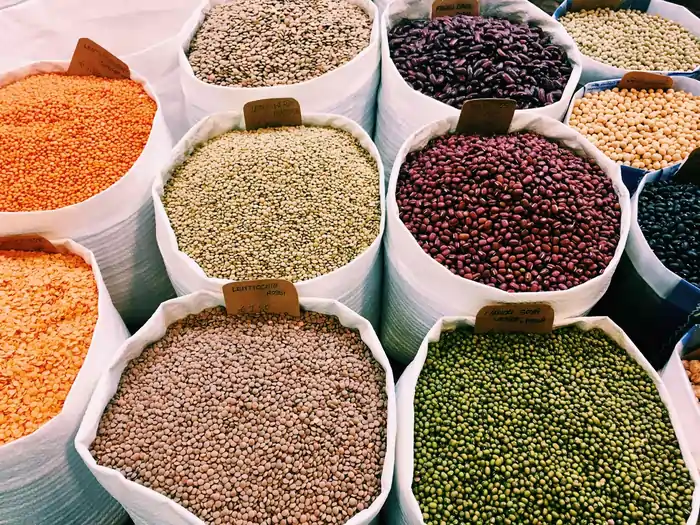
Image Source: VegNews.com
Dan Buettner’s take on the ultimate longevity food might surprise you. He skips exotic superfoods and expensive supplements and says, “I believe the only superfood there is in the world is beans” [9]. This simple legume, often overlooked by Western diets, is the life-blood of nutrition in all five Blue Zone regions where people live past 100 years.
Why beans are the #1 Blue Zone food
Blue Zone residents eat beans every day – about a cup, which is four times more than what Americans typically eat [8]. This simple habit links strongly to their remarkable longevity. Research shows eating just 20g of legumes daily (less than an ounce) reduces death risk by 6% [4].
Beans earn their superfood status through an impressive nutritional profile. They pack 21% protein and 77% complex carbohydrates with very little fat [8]. These powerhouses provide steady energy without spiking blood sugar and contain fiber that reduces blood pressure and “bad” cholesterol [8].
A daily cup of beans offers one of the cheapest, easiest and tastiest ways to improve your health. They lower cholesterol, stabilize blood sugar, and boost good gut bacteria [8]. Kidney beans stand out because their starches digest slowly, which helps maintain steady blood sugar [10].
Types of beans eaten in different regions
Each Blue Zone uses local legumes as dietary staples in their traditional cooking:
- Costa Rica: Black beans shine in breakfast burritos and gallo pinto (traditional rice and beans) [8]
- Greece: Garbanzo beans (chickpeas) in hummus and gigantes beans [11]
- Japan: Soybeans become tofu and miso [8]
- Sardinia: Fava beans and chickpeas [4]
- Ikaria: Garbanzo beans and lentils [4]
Different bean varieties offer unique benefits. Aduki beans have more fiber than most types, while fava beans pack the antioxidant lutein [4]. Black and dark red kidney beans provide rich potassium, and chickpeas deliver magnesium [4].
Easy ways to add beans to your meals
Research suggests eating a half cup to full cup of beans daily works best [12]. New bean eaters should start with two tablespoons daily, move up to four tablespoons, then reach for a full cup over two weeks [4].
Beans can do more than you might think. Here are some creative ways to use them:
- Transform soups and sauces: Beans make dairy-free soups creamy while adding fiber and protein [1]
- Reimagine desserts: They sneak nutrients into treats without changing the taste [1]
- Create quick meals: Stock canned beans for healthy, fast options [1]
Beans and whole grains together create complete proteins with all essential amino acids – just like meat [4]. Blue Zone cuisines showcase this powerful duo, like Costa Rica’s gallo pinto mixing beans with rice [4].
Beans connect all longevity diets worldwide. You can add this nutritional powerhouse to soups, salads, or main dishes and take a big step toward a Blue Zone lifestyle.
Cutting Back on Dairy and Eggs

Image Source: Gene Food
A peek into a Blue Zone refrigerator might surprise you – you won’t find cow’s milk. The way these long-lived populations use animal products tells an interesting story that’s quite different from Western habits. All but one of these Blue Zones avoid cow’s milk, with some Adventists in Loma Linda being the exception [5].
Why cow’s milk is rare in Blue Zones
Blue Zone elders grew up in times before dairy became a big industry. The human diet only started including dairy 8,000-10,000 years ago [5]. Our bodies aren’t built to handle milk products after infancy, and about 60% of people struggle to digest lactose [5].
Research points to good reasons to limit dairy intake. Dr. Gary Fraser, a Loma Linda cardiologist, found links between dairy milk and higher breast and prostate cancer risks [2]. The results showed up with whole and skim milk alike, and even small amounts – less than three-quarters of a cup daily – made an impact [2].
Goat and sheep milk alternatives
People in Ikaria and Sardinia reach for goat and sheep milk products instead of cow’s milk [13]. They don’t drink these straight but turn them into yogurt, sour milk, or cheese [14]. This fermentation creates healthy probiotics that boost digestive and immune health [14].
Goat milk comes with special benefits. It contains lactase, an enzyme that helps break down lactose, which makes digestion easier [15]. The milk’s protein structure is “A2 dominant,” which sets it apart from cow’s milk and helps with digestion [15].
Eggs: occasional and small portions
Blue Zone residents take a balanced approach to eggs. People eat them in all five Blue Zones, but just 2-4 times each week [5]. They use eggs as add-ons rather than making them the main breakfast feature [13].
Nicoyans might add an egg to their corn tortilla with beans, while Okinawans often drop one into their soup [5]. Mediterranean Blue Zone residents sometimes enjoy a morning fried egg alongside bread, almonds and olives [5].
The quality of eggs matters a lot. Blue Zone eggs come from free-range chickens that eat natural foods without hormones or antibiotics. These eggs naturally pack more omega-3 fatty acids [5]. This makes eggs an occasional protein boost rather than an everyday staple.
Sugar and Processed Foods: The Hidden Killers
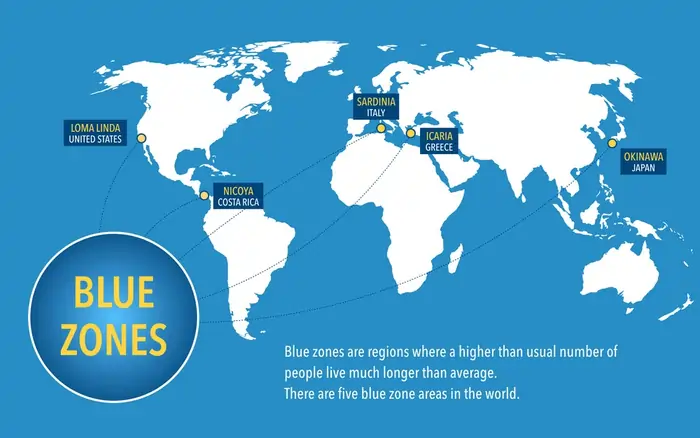
Image Source: Whole Harvest
Your sweet tooth might be quietly working against your health. Research from the world’s longest-lived communities backs this up. Modern diets are full of processed foods and sugar, but the blue zone diet takes a different path with these harmful ingredients and treats them with caution instead of daily use.
How much sugar is too much?
Americans consume about 22 teaspoons of added sugar daily. This amount is staggering compared to blue zone residents who stick to just 7 teaspoons (28 grams) per day [3]. Blue zone centenarians don’t completely avoid sugar. They just make conscious choices about it and don’t consume it out of habit [3].
Sugar hides everywhere in our food. The amount of added sugar in American food went up by 25% between 1970 and 2000 [3]. Blue zones get their sugar from natural sources like fruits and vegetables. They rarely eat processed products.
High sugar intake weakens your immune system, raises insulin levels, and leads to diabetes, lower fertility, weight gain, and a shorter life [3]. Blue zone residents save sweet treats like cookies and candy for special occasions [16].
Why Blue Zone diets avoid processed snacks
Ultra-processed foods speed up your body’s aging process. A notable study showed that people who ate the most ultra-processed foods had a 10% higher chance of dying during a 23-year follow-up period. Heart disease and diabetes were the main causes [6].
Sugar-sweetened drinks and processed meats showed the strongest links to death rates [17]. Blue zone diets focus on “foods that are recognizable” – simple items that are raw, cooked, ground, or fermented [3].
Processed foods aren’t just chips and candy. They include condiments, sauces, flavored yogurt, and granola bars [18]. Blue zones residents choose nutrient-dense, fiber-rich whole foods instead of artificial products [3].
Tips to reduce sugar in your daily routine
Start with your morning coffee or tea. Blue zone residents drink their coffee or tea without sugar. They slowly cut back on sweeteners when switching from sweetened drinks [19]. Try keeping added sugar to 4 teaspoons or less each day in your drinks and food [3].
Read labels while shopping. Don’t buy products with sugar listed in the first five ingredients [3]. To get natural sweetness without refined sugar, pick:
- Whole fruits for natural sweetness
- Small amounts of honey as a natural sweetener
- Unsweetened yogurt with fresh fruit instead of pre-sweetened varieties
The blue zone longevity diet includes treats too – they’re just saved for special moments rather than everyday habits [16].
Whole Grains, Nuts, and Oils
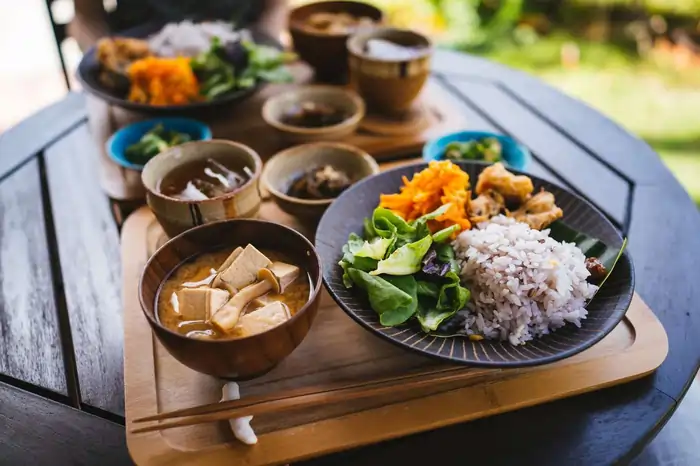
Image Source: Verywell Health
Traditional food preparation methods in Blue Zone communities reshape the scene of simple ingredients into nutritional powerhouses. These longevity diets’ life-blood consists of ancient bread-making processes, a daily handful of nuts, and generous use of plant-based oils. They provide sustained energy without the blood sugar spikes common in processed alternatives.
Sourdough and whole grain breads
People living in Ikaria and Sardinia welcome bread in its most wholesome form. Blue Zone bread is different from commercial varieties. They make it from whole grains such as wheat, rye, or barley [3]. These grains deliver a spectrum of nutrients like tryptophan, selenium, and magnesium that refined flours lack.
Traditional sourdough bread offers exceptional benefits, especially when you have naturally occurring lactobacilli bacteria. The bacteria digest starches and glutens as the bread rises [3]. This fermentation creates bread that has less gluten than many “gluten-free” products. It also produces an acid that gives sourdough its distinctive tangy flavor [3].
Authentic sourdough deserves attention because it lowers the glycemic load of your entire meal [20]. Your body uses these calories as energy instead of storing them as fat [3]. Notwithstanding that, moderation remains essential—keep your intake to two slices daily [21].
Nuts as daily snacks
Centenarians in Blue Zones of all types consume two handfuls (about four ounces) of nuts daily [22]. The Adventist Health Study 2 revealed impressive results—people who eat nuts live two to three years longer than those who don’t [3].
Women with high heart disease risk reduced their heart attack risk by nearly half when they ate nuts five or more days weekly [23]. A study of 7,000 people showed that doubling nut intake to about an ounce daily cut stroke risk by 50% [23].
The best mix has:
- Almonds (vitamin E and magnesium)
- Peanuts (protein and folate)
- Brazil nuts (selenium)
- Cashews (magnesium)
- Walnuts (alpha-linoleic acid—the only plant-based omega-3) [3]
Olive oil and other healthy fats
Blue Zone regions rely heavily on olive oil. Middle-aged people who consumed about six tablespoons daily cut their mortality risk in half [3]. This Mediterranean staple boosts good cholesterol while reducing bad cholesterol [3].
Olive oil’s monounsaturated fatty acids and antioxidant properties contribute to these regions’ healthy eating patterns [24]. People use it to drizzle over salads, dress vegetables, and simmer dishes—not for deep-frying. This approach boosts flavors while delivering heart-healthy benefits [24].
Okinawans primarily use canola oil [20], though most Blue Zones favor olive oil. This shows flexibility in choosing plant-derived fats over animal sources.
Drinks That Support Longevity
Blue Zone residents choose their drinks as carefully as their food. These choices are vital to their long lives. The drinks they consume or avoid tell us a lot about how beverages affect our lifespan.
Water as the main beverage
The world’s longest-living people stick to plain water most of the time. Adventists suggest drinking seven glasses of water each day. Their studies show that good hydration makes blood flow better and lowers the risk of blood clots [3].
Blue Zone residents don’t touch soft drinks at all. Most of these centenarians never tasted soda in their lives, including diet versions [3]. Americans get about half their sugar from soft drinks. This difference substantially explains why Blue Zone residents live longer.
Coffee and tea traditions in Blue Zones
The sort of thing I love about Blue Zone drinking habits are their unique patterns. People in Sardinia, Ikaria, and Nicoya drink lots of coffee [3]. Blue Zone coffee drinkers have lower rates of dementia, Parkinson’s disease, and several types of cancer [3].
Okinawans take a different approach. They prefer green tea and drink it throughout the day [3]. A study of 40,000 Japanese tea drinkers showed women had a 30% lower heart disease risk, while men’s risk dropped by 20% [25]. Old-time Ikarians made teas from wild herbs – rosemary, sage, and dandelion. These herbs are known to fight inflammation [3].
Red wine: moderation is key
Wine drinkers tend to live longer than those who don’t drink. Most Blue Zone residents enjoy one to three small glasses of red wine daily. They usually drink with meals and friends [3]. A 15-year study of 1,700 people in their 90s found something interesting. Those who had about two glasses of beer or wine daily were 18% more likely to live longer than those who didn’t drink [26].
Sardinians love their Cannonau wine. It contains two to three times more artery-cleaning flavonoids than other wines [4]. Drinking wine with food helps your body absorb more flavonoids [4].
The social aspect plays a big role too. Blue Zone residents get together for coffee or wine. These gatherings create meaningful connections that add to their long lives [12].
Conclusion
Living Longer Through Blue Zone Wisdom
People often ask if Blue Zone diets really work. The evidence definitely shows they do. Our research has found that there was a remarkable similarity in eating patterns among Blue Zone residents, even though they live oceans apart [27]. These communities follow a 95% plant-based diet rich in beans, whole grains, and nuts. This forms the life-blood of their extraordinary longevity .
You might wonder which Blue Zone practice affects health the most. The answer lies in beans as your dietary staple . This humble superfood appears on centenarian plates every day. It delivers steady energy, plant protein, and fiber that helps gut health and reduces inflammation . On top of that, it treats meat as a garnish rather than the main dish .
Blue Zone eating surprises many health enthusiasts. These residents don’t count calories or obsess over macros like modern diet culture suggests. They simply focus on whole, unprocessed foods with basic preparation methods . This natural approach eliminates most added sugars and artificial ingredients that speed up aging .
Many ask if they need to follow every Blue Zone rule. Here’s the good news – small, consistent changes can create the most important differences [11]. To cite an instance, grab a handful of nuts instead of processed snacks, or switch to sourdough bread. These changes can move your diet in a healthier direction [10]. Remember, progress matters more than perfection.
Nutritionists highlight Blue Zone hydration habits as crucial. Water serves as their main drink, though moderate amounts of coffee, tea, and even red wine prove beneficial when shared socially [28]. These beverages replace sugary drinks that contribute to modern disease patterns .
Starting a Blue Zone lifestyle doesn’t need to feel daunting. Begin with one simple change – maybe a daily serving of beans or one plant-based meal instead of meat each week. This creates momentum . Each small adjustment builds on previous ones and gradually reshapes your eating patterns .
A longer life isn’t just about more years – it’s about better living quality. Blue Zone diets show how food choices boost overall well-being beyond physical health . Their example proves that eating patterns can nourish our bodies, minds, and social connections all at once .
Our analysis of all five Blue Zones reveals a clear truth: lifestyle, not genetics, determines longevity. Genes influence only 20% of our lifespan potential. The other 80% depends on choices we can control . This strengthens our ability to shape our health destiny through mindful eating patterns that have kept centenarians healthy for generations .
FAQs
What is the main principle of the Blue Zone diet?
The Blue Zone diet is primarily plant-based, with about 95% of food coming from vegetables, fruits, whole grains, and especially beans. Meat is consumed sparingly, usually only a few times per month in small portions.
How often do people in Blue Zones eat beans?
People in Blue Zones eat beans daily, consuming about a cup – approximately four times more than the average American. This habit is strongly connected to their exceptional longevity.
What role does dairy play in the Blue Zone diet?
Cow’s milk is rare in most Blue Zones. Instead, some regions consume goat and sheep milk products, usually fermented into yogurt or cheese. Overall, dairy consumption is much lower compared to typical Western diets.
How do Blue Zone residents approach sugar and processed foods?
Blue Zone inhabitants limit sugar to about 7 teaspoons daily, compared to the 22 teaspoons consumed by the average American. They also avoid processed snacks, focusing on whole, single-ingredient foods that are raw, cooked, ground, or fermented.
What beverages are common in Blue Zone diets?
Water is the primary beverage in Blue Zones. Coffee is popular in some regions, while others prefer tea, especially green tea. Moderate consumption of red wine (1-3 small glasses daily) is also common, often enjoyed with meals and friends.
References
[1] – https://www.bluezones.com/2018/10/turn-1-can-of-beans-into-27-easy-creative-recipes/
[2] – https://www.businessinsider.com/blue-zone-doctor-loma-linda-california-diet-milk-cheese-2023-9
[3] – https://www.bluezones.com/recipes/food-guidelines/
[4] – https://www.bluezones.com/2017/08/longevity-link-how-and-why-wine-helps-you-live-longer/
[5] – https://www.bluezones.com/2020/07/blue-zones-diet-food-secrets-of-the-worlds-longest-lived-people/
[6] – https://www.health.harvard.edu/staying-healthy/eating-ultra-processed-food-may-shorten-life-span-among-older-adults
[7] – https://www.bluezones.com/2016/03/sourdough-bread/
[8] – https://www.bluezones.com/2022/01/5-delicious-ways-to-eat-a-cup-of-beans-each-day/
[9] – https://www.businessinsider.com/3-longevity-boosting-bean-recipes-from-recipe-developer-2024-9
[10] – https://www.esteelauder.com/blog-article-roar-forward-blue-zone-diet-tips?srsltid=AfmBOooUr0_2FdYf7CzHUh938zUmyyQYjD_H-45J_Ze6G9LMcFw4mGZH
[11] – https://ussec.org/delicious-soy-foods-in-blue-zones-longevity-diets/
[12] – https://danbuettner.com/newsletters/edition-3/
[13] – https://privatehomecare.com/blog/the-bluezone-diet-aging-food-secrets-of-the-worlds-longest-lived-people
[14] – https://news.leavitt.com/healthy-habits/blue-zones-food-guidelines/
[15] – https://www.wellandgood.com/food/blue-zones-dairy
[16] – https://www.verywellhealth.com/blue-zone-diet-foods-4159314
[17] – https://www.nature.com/articles/s43016-023-00868-w
[18] – https://www.businessinsider.com/blue-zones-longest-living-people-planet-diet-foods-to-avoid-2022-3
[19] – https://www.bluezones.com/four-best-foods-four-worst-foods-blue-zones-life/
[20] – https://www.gq.com/story/blue-zones-diet
[21] – https://www.bluezones.com/2016/12/5-things-know-whole-grains/
[22] – https://www.rupahealth.com/post/blue-zones-longevity-whats-their-secret
[23] – https://www.bluezones.com/2017/07/why-nuts-are-nutritional-powerhouse/
[24] – https://www.fustinis.com/blogs/blog/olive-oil-in-the-blue-zone-diet?srsltid=AfmBOoq6iEkFR_ZYfOk6IOTO20SsbzL6Bw92nQdwevvirAi3mhd8er54
[25] – https://www.bluezones.com/2019/10/what-happens-when-you-drink-tea-every-day/
[26] – https://www.bluezones.com/2018/02/drinking-glass-wine-taking-walk-may-be-key-to-longevity/
[27] – https://fortune.com/well/article/beans-superfood-blue-zone-diet/
[28] – https://www.mygenefood.com/blog/bean-health-benefits/
